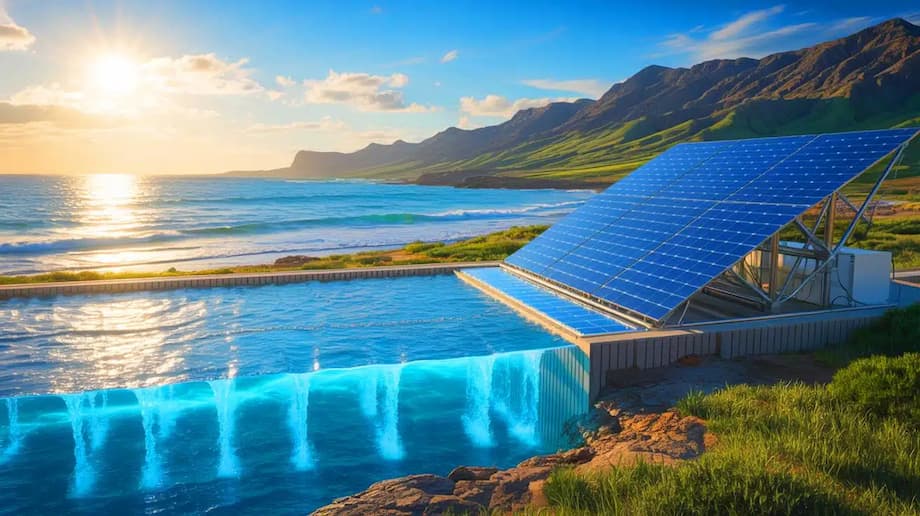An ultra efficient solar still from Korea
A research team at the Ulsan National Institute of Science and Technology (UNIST) in South Korea has developed a solar powered desalination device that reports an evaporation rate of 3.4 liters per square meter per hour under one sun. The prototype turns seawater into drinkable water without any external electricity, using sunlight and an advanced photothermal material called La0.7Sr0.3MnO3. The device also solves one of the toughest problems in solar desalination, the build up of salt on the evaporator surface that blocks light and stalls performance. By steering dissolved salt away from the hot center and toward the edges, the system keeps working for extended periods while producing clean water vapor that can be condensed into liquid.
- An ultra efficient solar still from Korea
- How the device works
- Why the material La0.7Sr0.3MnO3 stands out
- Tackling the salt problem
- Performance numbers in context
- How it compares with conventional desalination
- Use cases and deployment paths
- Scaling up and engineering challenges
- Climate and sustainability considerations
- What to Know
The work, led by Professor Ji Hyun Jang of UNISTs School of Energy and Chemical Engineering and published in Advanced Energy Materials, combines a simple paper based wicking structure with a high efficiency photothermal surface. In durability tests, the device operated stably for two weeks in brines with 20 percent salt content, far higher than the 3.5 percent salinity of typical seawater. The team says the same design can support resource recovery, including crystallizing and collecting salt at the edges instead of dumping concentrated brine back into the ocean.
Interest in passive solar desalination is rising as more regions face water stress. Billions of people do not have steady access to safely managed drinking water, and coastal communities often rely on diesel powered reverse osmosis plants that are expensive to run and produce large volumes of brine. A modular system that makes fresh water using only sunlight, with little maintenance and no grid power, could fill critical gaps for remote villages, islands, farms, and disaster relief operations. The UNIST device aims squarely at that need, trading high throughput plant infrastructure for simple materials, clever geometry, and sunlight.
How the device works
The UNIST design uses a distinctive inverse L shaped evaporator built around water absorbing paper. The paper acts like litmus paper and draws seawater upward by capillary action. At the top of the vertical section sits a light absorbing photothermal layer made from La0.7Sr0.3MnO3, a perovskite oxide that converts incoming sunlight into heat with high efficiency. When the seawater reaches this hot surface, it evaporates quickly and leaves the salt behind. The water vapor then travels to a cooler surface where it condenses and is collected as liquid fresh water.
A key feature is flow direction. The team engineered one directional fluid movement across the hot surface that creates a salt concentration gradient. Dissolved ions migrate toward lower water activity regions near the edges and crystallize as solid salt where they do not shield the light. This self clearing effect keeps the central photothermal zone open to sunlight while capturing salt at the margins for removal or reuse. The geometry and fluid path do the heavy lifting, reducing the need for pumps, membranes, or frequent manual cleaning.
Why the material La0.7Sr0.3MnO3 stands out
At the heart of the device is La0.7Sr0.3MnO3, often shortened to LSMO. It is a perovskite oxide, a class of materials known for tunable optical and electrical properties. Unlike the lead based halide perovskites common in solar cells, LSMO contains lanthanum, strontium, and manganese and does not rely on volatile or toxic lead. That makes it attractive for water applications where stability and environmental safety are essential.
LSMO excels as a photothermal converter because of how it handles excited charge carriers under sunlight. In simple terms, the material forms trap states within its electronic structure. When light knocks electrons into higher energy states, many recombine without emitting light, releasing their energy directly as heat instead. This non radiative pathway, often called thermalization, turns a high fraction of incoming solar energy into localized heat at the surface. Efficient heat release raises the temperature quickly and drives faster evaporation for a given amount of sunlight.
Tackling the salt problem
Salt fouling has long held back solar desalination. As water evaporates, dissolved salts concentrate and eventually crystallize on the hot surface. The crystals scatter light and block heat transfer, so evaporation rates fall sharply. Many earlier systems ran well for hours but then needed cleaning or had to pause to flush away salts. The UNIST team attacks this challenge with geometry and controlled flow rather than complex coatings or moving parts.
The inverse L shape and one directional flow generate a steady salt gradient that pushes ions away from the brightest hot zone. Crystals nucleate and grow at the edges where they are easy to collect. In laboratory tests the device kept performing for two weeks even in very salty solutions with 20 percent total dissolved salts. That level is typical of brines discharged from industrial processes and far above open ocean water, which indicates a strong margin for real world seawater operation and possible use in brine concentration and resource recovery.
Performance numbers in context
The reported evaporation rate is 3.40 kilograms per square meter per hour under one sun. One sun refers to standard test sunlight at about one kilowatt per square meter. Many passive solar stills produce around 0.3 to 0.4 kilograms per square meter per hour in similar tests, so the UNIST prototype runs eight to ten times faster. In practice, daily water output depends on local sunlight over the whole day and the efficiency of the condenser that turns vapor back into liquid. Under strong sun for several hours, a one square meter module at the reported rate could yield on the order of several tens of liters per day. Arrays of multiple modules could scale that further.
It is worth distinguishing evaporation rate from delivered drinking water. The lab number measures how much mass leaves the hot surface as vapor each hour. Real systems must capture and condense nearly all of that vapor into a clean reservoir, while minimizing heat loss. Good condenser design, thermal insulation, and re use of latent heat can push total system yield closer to the evaporator rate. The UNIST team also points to the devices antifouling behavior as a core contributor to steady output, since a clean photothermal surface maintains both light absorption and heat generation over time.
How it compares with conventional desalination
Reverse osmosis dominates modern desalination. It forces seawater through fine membranes at high pressure, producing large volumes of fresh water for cities and industry. That performance comes with tradeoffs. Reverse osmosis consumes several kilowatt hours of electricity per cubic meter of water produced, requires pre treatment to protect membranes, and discharges concentrated brine that must be managed responsibly. Plants are capital intensive and usually tied to the grid or to dedicated power sources.
A passive solar evaporator like the UNIST design sidesteps pressure, pumps, and high electrical demand. It produces less water per unit time and area, but it can operate off grid, quietly, and with simpler maintenance. The ability to direct salt crystallization to the edges also reduces the volume of brine. In suitable climates, a field of modular evaporators could supply drinking water for households, clinics, or farms, while larger installations could support community scale needs. For cities, solar evaporation is more likely to complement rather than replace high throughput plants, serving as a resilient backup or a solution for remote neighborhoods at the edge of the grid.
Use cases and deployment paths
The device targets settings where grid power is limited and maintenance crews are scarce. Island communities, fishing villages, and coastal farms fit that profile. So do humanitarian operations after storms, earthquakes, or conflicts where water infrastructure fails. The team’s concept is modular, so it can be deployed as single panels for small needs or as clusters for higher demand. Low noise and the absence of high pressure equipment also make it suitable for schools and clinics where reliability and safety matter.
Because the design drives salt to the margins, the system can also act as a resource recovery tool. Instead of discharging concentrated liquid brine, operators can collect dry salt and other crystallized minerals. That can reduce environmental impact and create small revenue streams. The team has suggested future versions that combine many inverse L shaped evaporators into larger modules, a pathway to more straightforward installation and maintenance in the field.
Scaling up and engineering challenges
Moving from lab prototypes to field hardware requires careful attention to materials, manufacturing, and thermal management. The evaporator’s paper wick needs to withstand months of wet dry cycles, biofouling from marine organisms, and ultraviolet exposure. The photothermal surface must retain its light absorption and heat conversion with minimal degradation. LSMO is an oxide perovskite with good thermal stability, which is helpful. Production methods will matter for cost. Techniques that coat large areas uniformly at low temperature can reduce expense and improve repeatability.
Condensation and heat recovery are central to system efficiency. Each kilogram of vapor carries a large amount of latent heat. Designs that condense vapor onto surfaces that share heat with incoming seawater can recycle that energy and boost total output. Enclosures should minimize heat loss and vapor leakage while remaining easy to clean. Dust, spray, and salt crystals must be managed with simple cleaning routines. The team’s durability tests at very high salinity are encouraging, yet multi month trials in coastal environments will help prove long term robustness and maintenance needs. Partnerships with aid organizations and local utilities can support those trials and guide design choices for different climates.
Climate and sustainability considerations
Solar desalination offers clear climate advantages for off grid sites. It replaces electricity with sunlight and avoids the fuel consumption and emissions of diesel generators. Life cycle impacts still matter, from the sourcing of lanthanum and strontium to manufacturing of the absorbers and housings. Using durable materials and simple assembly can extend operational life and spread embodied carbon over many years of service. The absence of high pressure pumps reduces both energy use and acoustic noise, which benefits coastal communities and wildlife.
Waste streams differ from conventional plants. By crystallizing salt at the edges, the UNIST approach can reduce discharges of concentrated brine into nearshore waters. Where feasible, collected salt can be reused in industrial processes or safely returned to salt pans. This aligns with efforts to make desalination more compatible with marine ecosystems and with the goals of clean water and sanitation under global development targets. As climate change drives more intense droughts and heat waves, practical tools that turn abundant seawater into safe drinking water with minimal energy will become part of many local adaptation plans.
What to Know
- UNIST researchers built an electricity free solar desalination device that reports 3.40 kilograms per square meter per hour under one sun.
- The design uses a paper wick and an inverse L shaped geometry to bring seawater to a photothermal surface.
- The photothermal layer is La0.7Sr0.3MnO3, an oxide perovskite that converts sunlight to heat through non radiative recombination.
- Salt is driven to the edges by a one directional flow pattern, reducing fouling and light blocking on the hot center.
- Durability tests showed stable operation for two weeks in solutions with 20 percent salt, higher than normal seawater.
- Typical passive solar stills deliver 0.3 to 0.4 kilograms per square meter per hour, so the reported rate is about eight to ten times higher.
- The concept supports salt harvesting and reduces liquid brine discharge compared with many conventional approaches.
- Arrays of modules could supply off grid water for villages, clinics, islands, and disaster relief operations.
- The research is published in Advanced Energy Materials and led by Professor Ji Hyun Jang with lead author Dr. Saurav Chaule.
- Field trials, condenser design, and scalable manufacturing will determine real world yields and costs.




